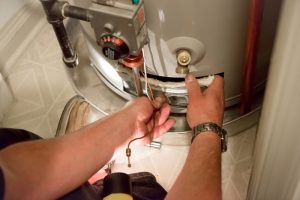 Most homes are equipped with tank water heaters. That’s no surprise, since they’re cheap and reliable, capable of lasting well over a decade. They’re also incredibly low-maintenance through most of their life. However, this low-maintenance might get some homeowners in trouble—there are several components of a tank water heater that do need to be looked at if they want their heaters to last past 15 years of age.
Most homes are equipped with tank water heaters. That’s no surprise, since they’re cheap and reliable, capable of lasting well over a decade. They’re also incredibly low-maintenance through most of their life. However, this low-maintenance might get some homeowners in trouble—there are several components of a tank water heater that do need to be looked at if they want their heaters to last past 15 years of age.
Just before fall is the perfect time to check in on your water heater. We’ll go over a few things to look out for.
Sediment Buildup
All water contains some level of minerals (unless it has been treated through a reverse osmosis water filter), and those minerals tend to separate in the heated chamber of a water heater. This results in a gradual buildup of sediment found sunken at the bottom of the tank. This sediment is harmless to you water heater and to your drinking water, but it will become a problem if it’s allowed to keep building.
Sediments will form a layer of insulation between the water and the burners, making it more difficult for the water to heat up. This means your water heater will stay on longer, and thus reduce its efficiency. However, that’s not the worst of it. Too much heat trapped beneath the sediment will create hotspots that can eventually burn through the tank itself.
Sediment buildup is easily removed from the system with an annual flush—the hard part is remembering to do it or to schedule a Livingston, NJ plumber to do it for you.
Temperature and Pressure Relief Valves
When water is heated, it expands. If it expands too much, it’s possible that your water heater can burst. At the wrong place and wrong time, a burst water heater can cause bodily harm to an individual.
Luckily, temperature and pressure relief valves are there to prevent that from happening. When either the temperature or the pressure in the tank becomes too much, the respective valve will open and release water to help return the tank to a normal level. These valves operate automatically and typically require little attention.
It’s crucial that these valves are tested at least once a year. If you haven’t had them tested recently, then right before fall is the perfect time.
Anode Rod
The tank of a water heater is a magnet for corrosive elements in the water. It wouldn’t take very long for corrosion to burn a hole through the tank, calling for a complete replacement. To combat this, an anode rod is used to attract those corrosive elements away from the tank. The purpose of the rod is purely to be attacked by this corrosion so that the tank can operate without problem.
Neglecting to change the anode rod can drastically decrease the lifespan of your water heater. It’s important to have it changed once every five years and to replace it when necessary.
